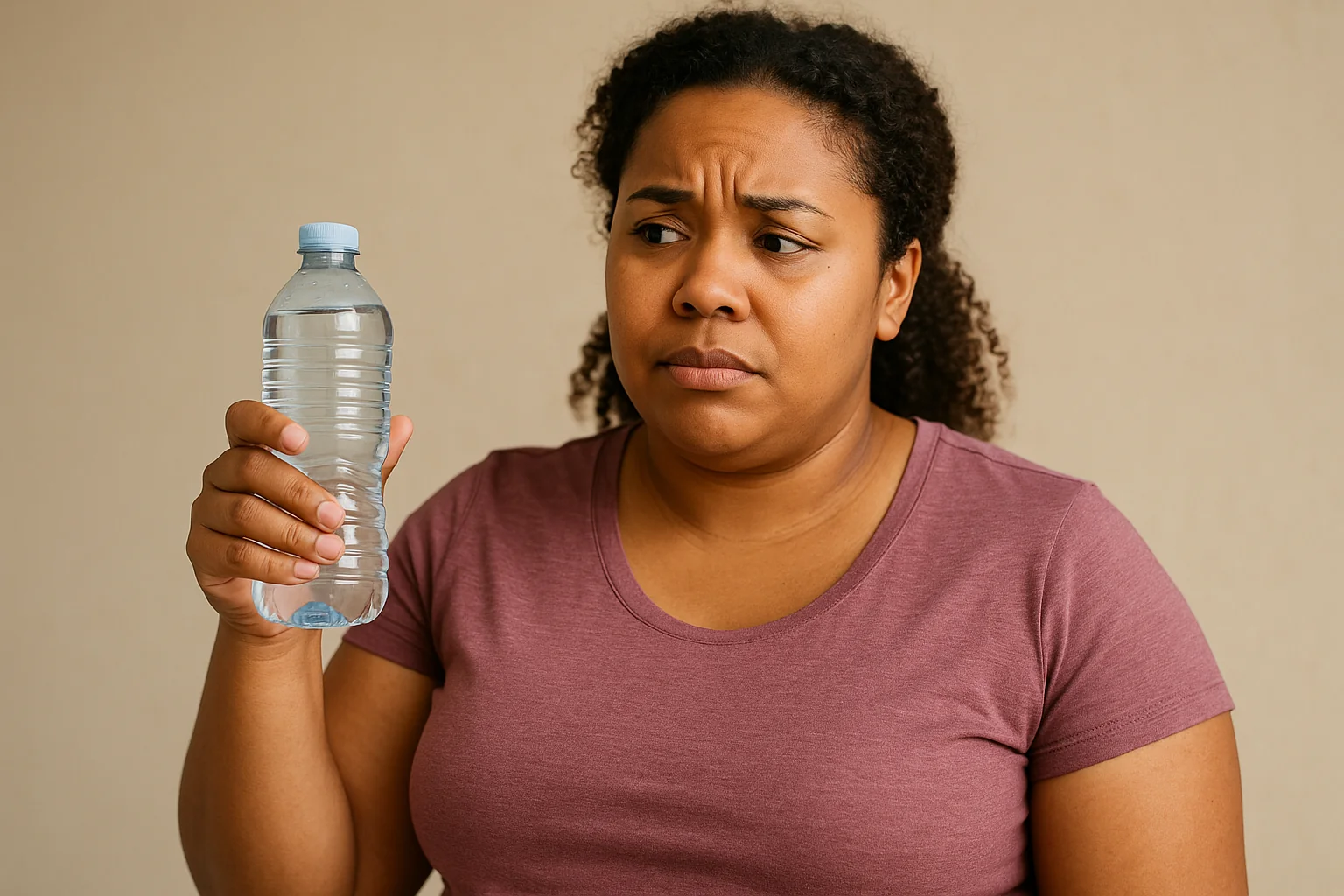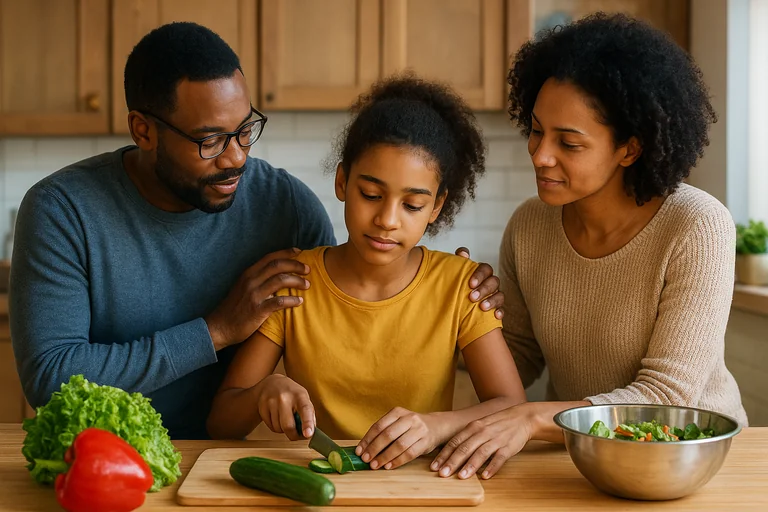A 2 minute assessment to get a personalized mental health or alcohol recovery plan.
Weight gain after quitting alcohol is common and explainable—alcohol calories disappear but appetite often rises due to reward substitution, sugar cravings, and sleep changes that can all be addressed without losing your sobriety progress.
What You'll Discover:
- Why removing alcohol calories doesn't always mean weight loss
- The science behind sugar cravings in early recovery
- How sleep changes affect appetite hormones
- A practical 4-week plan to reverse the weight gain
- When to consider additional support for cravings
- Quick rules you can implement today
You quit drinking and expected the scale to slide down. Instead, it crept up. Annoying? Definitely. Uncommon? Not really.
The first thing to know is this: most mainstream advice skips why this happens and what actually works to reverse it. This guide gives you the full picture—the physiology, the psychology, and a step-by-step plan—so you can keep the mental clarity of sobriety and get your body composition trending the way you want.
Why Weight Gain After Quitting Alcohol Is So Common
Calorie Math Meets Reward Biology
Alcohol is energy-dense at about seven calories per gram. For many people, those are add-on calories, not offset by eating less food. When you quit, those calories vanish—but your brain's reward system still expects an evening "hit."
Research shows that alcohol calories are often additive, not substituted for food. Many people unconsciously swap the alcohol reward for sugar, ultra-processed snacks, or bigger portions, keeping total calories high or even higher than before.
The Sugar Switch (And Why It's Not Just Willpower)
Early abstinence is frequently accompanied by elevated sweet cravings and increased sugar intake. A prospective study found that about 40% of patients increased sugar intake and experienced stronger cravings during alcohol withdrawal. That's not weakness—it's neurobiology.
Alcohol and sugar engage overlapping dopamine pathways in the brain. Remove alcohol, and sweet stimuli can temporarily take its place as your brain seeks that familiar reward signal.
Sleep Changes Can Push Appetite Up or Down
Alcohol wrecks sleep architecture. When you quit, sleep can improve—but not always immediately. In the meantime, short or fragmented sleep elevates ghrelin (the hunger hormone) and lowers leptin (the satiety hormone), pushing you toward bigger portions and increased snacking.
Even after sleep improves, habitual evening snacking patterns may linger. Addressing sleep is a weight strategy as much as a wellness one.
Recovery Routines: More Time, More Food Cues
Evenings that used to revolve around drinking now have empty space. If that space fills with grazing while streaming shows or frequent social meals (still alcohol-free, but appetizer-heavy), total calories climb.
A review on weight gain in early recovery highlights environment, stress reactivity, and learned eating patterns as drivers of overeating—all solvable with structured replacement habits.
The 4-Week Reset: Lose the Pounds, Keep the Sobriety Wins
The goal is to rebuild your metabolism's daily rhythm so blood sugar stays steady and hunger becomes predictable. You'll cut reward-seeking behaviors at night while keeping medical and coaching options on the table if cravings persist.
You don't need to do everything at once. Focus on the bold items first each week.
Week 1: Stop the 6-10 P.M. Calorie Spiral
Protein-anchor your late afternoon. Eat 25-35 grams of protein plus fiber between 4-5 p.m. Think Greek yogurt with berries, edamame with fruit, or turkey roll-ups with vegetables. This blunts the 6-8 p.m. "reward snack" urge.
Pick two non-alcoholic drinks you actually love. Choose complex, bitter, tannic, or spicy options—non-alcoholic bitters with soda and citrus plus a pinch of salt, iced tea with lemon, or hop water. Variety prevents boredom.
Close your kitchen two hours before bed. If you're truly hungry later, use a planned snack like high-protein yogurt or cottage cheese, not mindless grazing.
Create a 10-minute "urge circuit" at your danger hour. Brisk walk, hot shower, non-alcoholic drink in a nice glass, five-minute tidy. Repeat daily for seven days. Yes, repetition wires habits quickly.
Hydrate strategically. Two big glasses of water between 5-8 p.m. helps, but don't overdo it late—that can fragment your sleep.
Week 2: Rebalance Blood Sugar and Sleep
Protein at breakfast (25-35 grams) and front-loaded carbs like oats or fruit by midday, then vegetables plus lean protein at dinner. Predictable hunger means fewer pantry raids.
Set a caffeine curfew for 2 p.m. Sleep quality tonight controls appetite tomorrow. This is one of the most powerful levers you have.
Get light and movement within 60 minutes of waking. Just five to ten minutes outside makes a difference for your circadian rhythm and appetite regulation.
Keep bedtime within 30 minutes the same time every night. This isn't just sleep hygiene—it's an appetite intervention. Sleep loss and irregular timing push ghrelin up and leptin down, priming overeating.
If sweets call at 9 p.m., swap the form but not the feeling. Try frozen red grapes, apple slices with peanut butter, or 85% dark chocolate (pre-portioned). These satisfy the craving and self-limit intake.
Week 3: Stabilize Daytime Intake and Cut "Accidental" Calories
Eat three structured meals plus one planned snack. Grazing escalates total intake without you noticing. Structure makes satiety predictable and measurable.
Upgrade carbs to "protein-carb" pairings. Fruit with nuts, crackers with tuna, rice with chicken or tofu and a heap of vegetables. The protein slows digestion and keeps you full longer.
Audit your non-alcoholic beverages. Some are loaded with sugar. Choose mostly unsweetened options and save sweet non-alcoholic drinks for after dinner, and only if planned.
Add a 12-15 minute strength routine three times this week. Push, pull, squat, hinge movements. Muscle is your long-term ally for weight maintenance and metabolic health.
Week 4: Lock In Your Defaults and Design Your Environment
Choose your default week. Are you staying completely alcohol-free, or practicing mindful drinking with alcohol-free days at home, only drinking with meals, and capping at two standard drinks on one weekend night? Write it down explicitly.
Create three hard rules that eliminate negotiation. Examples: "No food from package to couch," "Kitchen closed at 9 p.m.," "Dessert only after eating protein."
Stock your house for the person you want to be. Clear trigger snacks from easy reach. Put non-alcoholic favorites at eye level. Make the right choice the easy choice.
Track the basics weekly, not daily. Average sleep hours, steps or strength sessions, waist or hip measurements, and how often you ate to 7 out of 10 fullness instead of stuffed. Weekly tracking reduces obsession while maintaining awareness.
Troubleshooting Common Patterns
"I'm crushing sweets at night."
Eat a real dinner with protein, fiber, and colorful vegetables. Pre-portion sweets like single-serve dark chocolate or mini ice cream bars and pair them with protein. Make a no-screens dessert rule—sit at a table. Screen pairing drives mindless refills.
"I'm hungrier since quitting."
That's normal for many people in early abstinence. Increase protein to 1.4-1.6 grams per kilogram of body weight per day, plus 30-40 grams of fiber daily. Steady meals tame ghrelin spikes effectively.
"I swapped wine for non-alcoholic beer...three of them."
Great harm reduction move, but calories can still add up. Choose mostly unsweetened non-alcoholic options and reserve caloric drinks as planned treats, not automatic habits.
"Weekends ambush me."
Load novelty into Saturday afternoon—new hiking trail, new recipe, game night with friends. Your brain loves novelty as much as it loved the old ritual. Novelty crowds out boredom grazing.
"My appetite feels intense."
Early recovery research documents increased sweet intake and cravings for a significant number of people—exactly what you're describing. Stabilize sleep and meals first. If the drive stays strong after 4-6 weeks, talk to a clinician about medication-assisted support for cravings.
A Sample Day That Fights Cravings and Cuts Calories
Breakfast (8:00 a.m.): Vegetable omelet with whole-grain toast, or high-protein Greek yogurt bowl with berries and chia seeds.
Midday (12:30 p.m.): Big salad with leafy greens, chickpeas or grilled chicken, olive oil and vinegar dressing, fruit on the side.
Snack (4:30 p.m.): Cottage cheese with pineapple, or apple slices with peanut butter.
Dinner (7:00 p.m.): Stir-fry with tofu or chicken, loads of vegetables, measured portion of brown rice.
Evening ritual (8:30 p.m.): Shower, non-alcoholic drink in a stemmed glass, five-minute tidy, then book or podcast.
Kitchen closed (9:00 p.m.) unless you're truly hungry, then a planned protein snack only.
When to Consider Extra Help
If you keep sliding into high-calorie compensations despite trying these strategies, get support. Behavioral coaching and peer groups make environment changes stick better.
If alcohol cravings remain the "engine" driving nighttime eating or relapse risk, naltrexone—a first-line, non-addictive medication for alcohol use disorder—can help many people reduce the pull of alcohol so your nutrition plan actually gets a chance to work.
Two practical guides from our library that pair well with this article:
- Two weeks without alcohol: The surprising ways your body and mind begin to heal
- Mindful drinking: How to be more intentional with alcohol
10 Fast Rules to Keep
Screenshot this list and refer back when you need a quick reset:
- Protein at breakfast, protein at dinner
- No "package to couch"—plate everything you eat
- Two go-to non-alcoholic drinks you actually like
- Kitchen closed two hours before bed
- Caffeine curfew at 2 p.m.
- Bedtime within 30 minutes the same time nightly
- Default week written down and visible
- Strength training three times per week (12-15 minutes is enough)
- Weekend novelty beats boredom grazing
- One slip doesn't equal a lost week—reset the same day
If You Want a Tailored Plan
If quitting revealed just how entangled alcohol was with your appetite and energy patterns, you're not alone. The good news: you don't have to choose between mental clarity and your goal weight.
If alcohol cravings keep nudging your eating off track—or you simply want a clear, supported path forward—naltrexone is a first-line medication that helps many people reduce the rewarding pull of alcohol so behavior change can stick.
Choose Your Horizon delivers 100% virtual naltrexone care with physician supervision, weekly support groups, and coaching, plus discreet at-home delivery and a simple dashboard to track your progress.
If you're curious whether this might be a fit for you, take our quick, confidential assessment.
You've already done the hard thing by quitting. With a few targeted tweaks and support if you want it, you can feel great and like what you see on the scale.
References
- Alcohol contribution to total energy intake and its relationship with drinking patterns
- Sugar intake and craving during alcohol withdrawal in alcohol use disorder
- Explaining excessive weight gain during early recovery from alcohol and drug use
- Sleep deprivation effects on weight loss and appetite regulation
- Energy labeling of alcoholic drinks context and evidence




